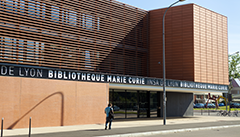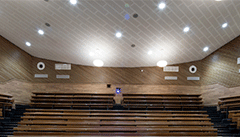
Sciences & Société
Soutenance de thèse : Kayacan KESTEL
« Development of signal processing techniques for vibration-based condition monitoring of industrial rotating machines »
Doctorant : Kayacan KESTEL
Laboratoire INSA : LVA
École doctorale : ED162 : MEGA de Lyon (Mécanique, Energétique, Génie civil, Acoustique)
This dissertation introduces novel signal processing techniques and enhances existing ones for vibration-based condition monitoring of complex industrial rotating machines. The vibration-based condition monitoring field literature provides many solutions to reveal faulty patterns from a vibration signal. However, their performance on the vibration signals of modern complex machines has not been tested or is generally limited. Furthermore, they may often lack a robust version ready to be applied to real measurements. This study addresses these limitations with several proposals. Key research areas include the development of a stable blind filtering method to optimize Finite Impulse Response (FIR) filters for efficient fault detection and testing the proposed method on vibration signals obtained from a wind turbine gearbox. Additionally, the thesis advances the use of Generalized Likelihood Ratio test (GLRT)-based indicators for more stable and effective monitoring and proposes new statistical indicators with defined thresholds for improved reliability. Furthermore, it explores the impact of operational and environmental conditions on the vibratory behavior of wind turbine drivetrains, aiming to enhance the understanding and assessment of gearbox health through dynamic behavior analysis under varying conditions. These contributions offer substantial advancements in the practical application of signal processing in condition monitoring.
Información adicional
-
Amphithéâtre Ouest, Bâtiment des Humanités, INSA-Lyon (Villeurbanne)
Últimos eventos
32e édition du festival Un Doua de Jazz
Desde 01 Hasta 11 Oct
Sciences & Société
Soutenance de thèse : Victor PINARDON
Étude et modélisation des roulements à rouleaux coniques montés dans une roue d’aéronef
Doctorant : Victor PINARDON
Laboratoire INSA : LaMCoS
École doctorale : ED162 : MEGA de Lyon (Mécanique, Energétique, Génie civil, Acoustique)
Les roulements à rouleaux coniques présents dans les roues d’aéronefs sont fortement sollicités lors des phases où l’avion est en contact avec le sol. Leur dimensionnement et intégration dans la roue requièrent donc une attention particulière. Cette thèse explore notamment les risques liés à la rotation de la bague externe d’un roulement à rouleaux coniques dans son logement lorsqu'il est soumis à un chargement thermique provenant du frein. En effet, ces roulements sont montés avec un ajustement serré dans le logement. De plus, lors de cas de chargements mécaniques sévères tel qu’un virage de l’avion sur la piste, les efforts internes du roulement peuvent générer un couple de frottement élevé. Ainsi, sous un chargement thermique spécifique et en raison des coefficients de dilatation thermique différents entre la bague et le logement, une perte de serrage peut se produire et entraîner une rotation relative entre la bague externe et le moyeu de la roue dans lequel le roulement est monté. Ce phénomène de glissement dégrade les performances du roulement et peut conduire à de l’endommagement. Une approche semi-analytique est appliquée à un roulement à bagues rigides pour déterminer les efforts de contact entre les rouleaux et les pistes. Ces efforts sont des données nécessaires pour évaluer le couple de fonctionnement du roulement. Le couple est estimé avec des modèles empiriques proposés dans la littérature et basés sur la théorie EHL. Un modèle thermomécanique transitoire est ensuite utilisé pour étudier l'évolution du couple de serrage entre la bague et le moyeu. Enfin, le code de calcul de roulement à bagues rigides est modifié pour intégrer les déformations de la bague externe afin d’évaluer l’impact de ces déformations sur le couple de frottement du roulement. Ces modèles sont appliqués sur deux roues appartenant à des avions différents.
Información adicional
-
Amphithéâtre Émilie du Châtelet (BMC), INSA-Lyon (Villeurbanne)
Palabras clave
Últimos eventos
32e édition du festival Un Doua de Jazz
Desde 01 Hasta 11 Oct
Sciences & Société
Soutenance de thèse : Thomas LEBRUN
Health Data: Exploring And Enhancing Emerging Privacy- Protection Mechanisms
Doctorant : Thomas LEBRUN
Laboratoire INSA : CITI
École doctorale : ED512 Informatique et mathématiques de Lyon
Les données de santé représentent une grande quantité d'informations, générées quotidiennement et sensibles par nature. Cependant, leur partage est essentiel pour l'avancement de la recherche et, en fin de compte, l'amélioration des soins aux patients. L’utilisation des données médicales est confrontée à des limitations dues à leur sensibilité et à la nécessité de garantir la confidentialité, encadrée par les réglementations en vigueur. Cela nécessite une protection renforcée. L’intérêt pour des alternatives au partage de données brutes, telles que la pseudonymisation ou l’anonymisation, augmente avec les besoins d’accès à des données d’apprentissage pour l’utilisation de l’intelligence artificielle, qui requiert de grandes quantités de données pour fonctionner efficacement en tant qu’assistant médical. Dans cette thèse, nous examinons de nouvelles méthodes respectant la vie privée, rendues possibles par les avancées rapides de l’intelligence artificielle. Plus spécifiquement, mon analyse porte sur l’amélioration d’alternatives à la centralisation de données sensibles : l’apprentissage fédéré, une méthode décentralisée d’entraînement des modèles d’IA sans partage de données, ainsi que de la génération de données synthétiques, qui crée des données artificielles similaires aux données réelles. Considérant l’absence de consensus pour l’évaluation de la confidentialité de ces nouvelles approches, nous avons axé notre travail sur la mesure méthodique de la fuite de confidentialité ainsi que la balance avec l'utilité des données synthétiques ou du modèle d'apprentissage fédéré. Mes travaux incluent un mécanisme pour améliorer les propriétés de confidentialité de l'apprentissage fédéré ainsi qu'une nouvelle méthode de génération conditionnelle de données synthétiques. Cette thèse vise à contribuer au développement de cadres plus robustes pour le partage sécurisé des données de santé, en conformité avec les exigences réglementaires, facilitant ainsi des innovations en matière de santé.
Información adicional
-
Salle 202/203, Bibliothèque Marie-Curie, INSA-Lyon (Villeurbanne)
Últimos eventos
32e édition du festival Un Doua de Jazz
Desde 01 Hasta 11 Oct
Sciences & Société
Soutenance de thèse : Büşra DURAN
Influence of gear transmission oils degradation on tribological performance and gearbox efficiency
Doctorante : Büşra DURAN
Laboratoire INSA : LaMCos
École doctorale : ED162 : Mécanique, Energétique, Génie Civil, Acoustique de Lyon
Les lubrifiants jouent un rôle clé dans la réduction du frottement, mais peuvent se dégrader au cours de leur utilisation, ce qui peut compromettre la fiabilité et l'efficacité des équipements. Définir une stratégie de lubrification optimale nécessite donc une compréhension approfondie des impacts potentiels de la dégradation des huiles.
Pour étudier ce phénomène, plusieurs lots d'huiles de transmission par engrenage ont été analysés et testés afin d'évaluer les changements entre les échantillons neufs et les échantillons prélevés en application. Dans un premier temps, certaines propriétés rhéologiques et chimiques des huiles ont été mesurées et analysées, telles que la viscosité, la composition chimique, l'acidité, la teneur en eau et la contamination en particules solides. Ensuite, les performances tribologiques des huiles ont été évaluées à l'aide de deux tribomètres distincts, complétés par des méthodes optiques de caractérisation des éprouvettes d’essais. Enfin, des essais sur un banc d’essai de transmission ont été effectués sous différentes conditions de fonctionnement pour étudier l'évolution de la dissipation de puissance et du comportement thermique du banc d'essai. De plus, un modèle numérique basé sur un couplage thermique a été utilisé pour exploiter davantage les données expérimentales.
Les résultats de cette étude démontrent une influence claire du fonctionnement des transmissions à engrenages sur les propriétés et la performance des lubrifiants. Les propriétés intrinsèques ont tendance à évoluer avec la dégradation donc les performances tribologiques sont également affectées. Dans le banc d'essai de transmission, la dégradation entraîne une évolution de la puissance dissipée, qui affecte à son tour le comportement thermique. Ces observations semblent également fortement dépendantes des conditions de fonctionnement en application.
Información adicional
-
Amphithéâtre Clémence Royer (bâtiment Jacqueline Ferrand) - (Villeurbanne)
Palabras clave
Últimos eventos
32e édition du festival Un Doua de Jazz
Desde 01 Hasta 11 Oct
Sciences & Société
Soutenance de thèse : Loup PLANTEVIN
Développement d'un procédé de traitement de surface par impulsions électromagnétiques et étude des transformations mécaniques induites
Doctorant : Loup PLANTEVIN
Laboratoire INSA : LaMCoS
École doctorale : ED162 : MEGA de Lyon (Mécanique, Énergétique, Génie civil, Acoustique)
Le traitement de surface de métaux est un point clé dans les secteurs nécessitant une forte résistance aux environnements très contraints, car il améliore les caractéristiques de la pièce traitée. Traditionnellement, le grenaillage (impacts de billes sur cette pièce) est la méthode la plus courante. Cette méthode, bien que simple à mettre en place, présente de nombreux inconvénients. Issu donc d'un besoin industriel, le grenaillage par impulsions électromagnétiques est une méthode innovante, traitant plus en profondeur, de manière plus contrôlée et sans pollution ni altération de l'état de surface.
Cette méthode, encore très peu étudiée dans le monde, sera présentée dans ces travaux. Le détail physique du phénomène sera d'abord exposé, afin d'en expliquer le fonctionnement, d'en caractériser ses bénéfices attendus ainsi que de dresser un cahier des charges pour sa réalisation pratique. Une fois ces fondations théoriques posées, une partie expérimentale présentera le dispositif de traitement retenu. De par la grande quantité d'énergie nécessaire pour le traitement, un soin particulier est pris pour la conception de ce dispositif. Celui-ci sera utilisé sur deux géométries d'aluminium AA6061 : un prisme et un cylindre.
Enfin, l'exploitation des résultats obtenus à partir du dispositif expérimental montreront la validation d'excellentes capacités du traitement de surface proposé. Notamment, la méthode a permis de multiplier par 15 la profondeur exploitable de traitement, ce qui ouvre la voie à de nombreuses applications inenvisageables jusque-là.
Par ailleurs, des méthodes originales de mesures et caractérisations ont été étudiées. De nombreux capteurs magnétiques ont été évalués et comparés. Ces capteurs permettent une indication rapide, simple et non-invasive sur la qualité du traitement effectué.
Información adicional
-
Amphithéâtre Emilie du Châtelet (Bibliothèque Marie Curie) - Villeurbanne
Últimos eventos
32e édition du festival Un Doua de Jazz
Desde 01 Hasta 11 Oct
Sciences & Société
Soutenance de thèse : Rodolphe VAUTHERIN
Incinération de déchets dangereux : vers une économie circulaire. Cas particulier de la valorisation du soufre
Doctorant : Rodolphe VAUTHERIN
Laboratoire INSA : DEEP
École doctorale : ED206 : Chimie de Lyon (Chimie, Procédés, Environnement)
Les déchets liquides contenant du soufre organique sont des déchets dangereux qui nécessitent une élimination par incinération. L’entreprise SUEZ IWS, via son unité de Roussillon, traite une grande quantité de ces déchets, générant du SO2 dans les fumées d’incinération. Actuellement, ce SO2 est simplement traité sur le site. Cette thèse vise évaluer l’intégration d’un nouveau procédé de désulfuration pour valoriser le SO2 sous forme d’une solution de bisulfite de sodium concentrée, tout en épurant la grande majorité du SO2 contenu dans les fumées. Une étude à échelle laboratoire a été menée sur un gaz synthétique pour examiner la réaction entre le dioxyde de soufre et le sulfite de sodium. L’influence de la concentration en Na2SO3, de la température et du taux de SO2, a été étudié, avec un focus concernant l’effet du pH sur le rendement d’absorption. Les performances du procédé ont ainsi été évalué en milieu acide et basique. Un pilote industriel a ensuite été installé sur le site de Roussillon pour tester le procédé en conditions réelles. Bien que des rendements d’absorption élevés aient été observés, les concentrations en bisulfite de sodium obtenues n’ont pas été suffisantes pour une commercialisation de la solution. De plus, certaines espèces secondaires indésirables ont été détectées dans les solutions. Des pistes d’améliorations ont été identifiées pour augmenter les concentrations en bisulfite et améliorer la qualité des solutions. La modélisation a finalement été utilisée pour analyser le procédé et mettre en évidence les paramètres clés pour optimiser les rendements d’absorption à pH acide, étude qui n’a pas pu être réalisé à échelle pilote. Cette partie a révélé la nécessité d’ajouter une étape supplémentaire au procédé initial pour obtenir une solution de bisulfite de sodium plus concentrée. Globalement, cette thèse présente des résultats prometteurs pour la mise en œuvre industrielle de ce procédé.
Información adicional
-
Amphithéâtre Laura Bassi, INSA-Lyon (Villeurbanne)
Últimos eventos
32e édition du festival Un Doua de Jazz
Desde 01 Hasta 11 Oct
Sciences & Société
Soutenance de thèse : Alix JEANNEROT
Uplink Resource Allocation Methods for Next-Generation Wireless Networks
Doctorant : Alix JEANNEROT
Laboratoire INSA : CITI
École doctorale : ED160 : EEA (Electronique, Electrotechnique, Automatique)
Face à la diversité des besoins en communication des réseaux 5G et 6G, l'allocation des ressources disponibles est considérée comme un élément clé pour augmenter la densité de dispositifs, leur débit ou la fiabilité des communications. Dans les réseaux de communication de type machine, des travaux récents ont proposé d'adapter l'allocation des ressources temporelles en fonction du processus sous-jacent qui régit l'activité des dispositifs. Cette thèse se concentre tout d'abord sur l'étude de l'impact d'une connaissance imparfaite de ce processus, et propose des méthodes pour atténuer le biais induit par les connaissances erronées. Ensuite, un algorithme permettant d'optimiser conjointement l'allocation des ressources temporelles et la puissance de transmission des dispositifs est proposé. L'algorithme permet aux dispositifs ayant une forte probabilité de transmettre sur les mêmes ressources de le faire avec une diversité de puissance suffisante pour assurer qu’ils soient décodables par la station de base. Enfin, dans les réseaux ayant un objectif de haut débit, nous proposons d'optimiser conjointement la puissance, les ressources fréquentielles ainsi que le nombre de couches utilisées par les dispositifs. Notre étude par simulations montre que notre optimisation conjointe est significativement plus performante que les méthodes utilisées actuellement en 5G pour lesquelles ces paramètres sont calculés indépendamment les uns des autres.
Información adicional
-
Amphithéâtre Ouest, Bâtiment des Humanités, INSA-Lyon (Villeurbanne)
Últimos eventos
32e édition du festival Un Doua de Jazz
Desde 01 Hasta 11 Oct
Sciences & Société
Soutenance de thèse : Victor BUSSY
Integration of a priori data to optimise industrial tomographic reconstruction
Doctorant : Victor BUSSY
Laboratoire INSA : LVA
École doctorale : ED160 : EEA (Electronique, Electrotechnique, Automatique)
L'objectif de mes travaux est de proposer une nouvelle méthodologie optimisée en tomographie par rayons X qui inclue l'incorporation d'informations a priori. De part l'optimisation des choix des vues, du support de la reconstruction et d'une régularisation adapté, plusieurs contributions ont été faites afin d'optimiser la qualité du processus globale. Les résultats de chaque partie ont été publié et testé dans cette thèse sur une pièce expérimentale.
Información adicional
-
Amphithéâtre de Digitéo, Bâtiment 565, CEA Saclay (Gif-sur-Yvette)
Últimos eventos
32e édition du festival Un Doua de Jazz
Desde 01 Hasta 11 Oct
Sciences & Société
Soutenance de thèse : Pierre-Yves GENEST
Unsupervised Open-World Information Extraction From Unstructured and Domain-Specific Document Collections
Doctorant : Pierre-Yves GENEST
Laboratoire INSA : LIRIS
École doctorale : ED512 : InfoMaths de Lyon
The exponential growth in data generation has rendered the effective analysis of unstructured textual document collections a critical challenge. This PhD thesis aims to address this challenge by focusing on Information Extraction (IE), which encompasses four essential tasks: Named Entity Recognition (NER), Coreference Resolution (CR), Entity Linking (EL), and Relation Extraction (RE). These tasks collectively enable extracting and structuring knowledge from unformatted documents, facilitating its integration into structured databases for further analytical processes.
Our contributions start with creating Linked-DocRED, the first large-scale, diverse, and manually annotated dataset for document-level IE. This dataset enriches the existing DocRED dataset with high-quality entity linking labels. Additionally, we propose a novel set of metrics for evaluating end-to-end IE models. The evaluation of baseline models on Linked-DocRED highlights the complexities and challenges inherent to document-level IE: cascading errors, long context handling, and information scarcity.
We then introduce PromptORE, an unsupervised and open-world RE model. Adapting the prompt-tuning paradigm, PromptORE achieves relation embedding and clustering without requiring fine-tuning or hyperparameter tuning (a major weakness of previous baselines) and significantly outperforms state-of-the-art models. This method demonstrates the feasibility of extracting semantically coherent relation types in an open-world context.
Further extending our prompt-based approach, we develop CITRUN for unsupervised and open-world NER. By employing contrastive learning with off-domain labeled data, CITRUN improves entity type embeddings, surpassing LLM-based unsupervised NERs, and achieving competitive performance against zero-shot models that are more supervised.
These advancements facilitate meaningful knowledge extraction from unstructured documents, addressing practical, real-world constraints and enhancing the applicability of IE models in industrial contexts.
Información adicional
-
Salle 501.337, Bâtiment Ada Lovelace, INSA-Lyon (Villeurbanne)
Últimos eventos
32e édition du festival Un Doua de Jazz
Desde 01 Hasta 11 Oct
Sciences & Société
Soutenance de thèse : Flora ESTERMANN
Détection et segmentation des anomalies en imagerie ultrasonore 3D et en imagerie industrielle par des approches d’apprentissage automatique supervisées ou non supervisées
Doctorante: Flora ESTERMANN
Laboratoire INSA : CREATIS
École doctorale : ED160 : EEA (Electronique, Electrotechnique, Automatique)
La détection d’anomalies faiblement contrastées dans les images est une problématique partagée à la fois par le domaine médical et l'industrie. Au cours de cette thèse, nous avons développé des méthodes d’apprentissage automatique pour la détection d’anomalies dans deux contextes différents: la détection des lésions ponctuées de la substance blanche (PWML) en échographie 3D chez les enfants prématurés par apprentissage supervisé pour notre application médicale, et la détection de défauts par apprentissage non supervisé pour des applications industrielles.
Le premier chapitre du manuscrit fournit une vue d’ensemble des quatre thématiques principales de nos recherches avec l’état de l’art correspondant : segmentation et classification supervisées pour la détection des lésions, classification non supervisée pour la détection des défauts, quantification des incertitudes pour l’explicabilité des résultats. La suite du manuscrit décrit séquentiellement les contributions de la thèse au domaine. Le deuxième chapitre présente notre étude sur les caractéristiques des PWML à l’échographie et introduit l’approche que nous avons proposée afin de réaliser la sur-segmentation des PWML dans les volumes ETF. Le troisième chapitre s’attaque directement aux méthodes de classification multi-vues proposées pour améliorer la précision de nos prédictions après la segmentation, et détaille également la manière dont nous avons intégré le cadre des prédictions conformes afin d’apporter une meilleure interprétabilité des résultats et un niveau de confiance plus élevé pour les médecins. Enfin, le dernier chapitre présente les approches non supervisées proposées pour la détection des défauts dans les images industrielles, en intégrant la détection conforme des anomalies également.
Nos résultats sont très encourageants pour le futur de l’intégration des modèles d’IA dans l’aide au diagnostic. De plus, dans le but de rendre nos modèles plus interprétables aux yeux des praticiens et des industriels, nous avons également traité la quantification des incertitudes en considérant le cadre des prédictions conformes dans nos approches.
Información adicional
-
Amphithéâtre de BU, Lyon 1 (Villeurbanne)

